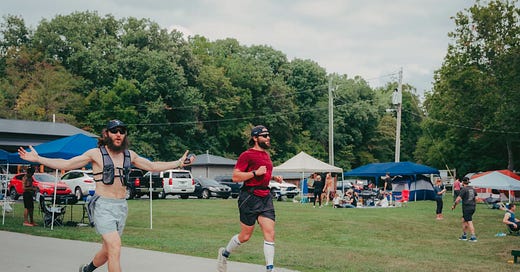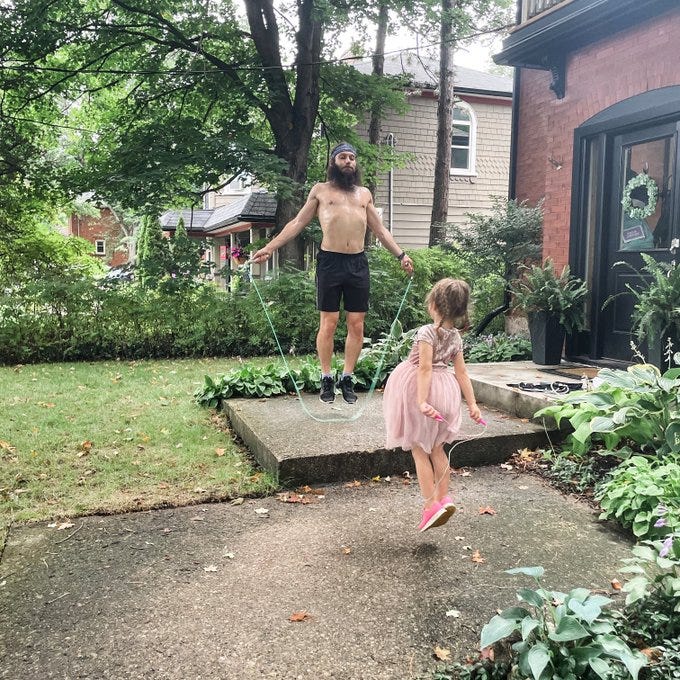The best cross training advice for running
This one peice of equipment can prepare you for the long haul
You’re running? Better stop before you get hurt!
When I started running consistently I was warned it was ‘bad for my knees.’
To be honest, I was a bit scared from the warnings.
But I’ve been running 10+ years, getting faster and going farther each year, and haven’t experienced any of the paid the ‘haters’ told me I was in for
How did I do it?
Let me tell you the story of my client ‘S’ to help you the same way I’ve used my experience to get him running pain free while losing 40lbs and getting him off blood pressure meds.
There’s a lot to this story, but I want to focus on one aspect that I believe will help current runners and those who have an interest in running but fear injury.
Proper cross training using one of the cheapest and most effective pieces of workout equipment: The Jump Rope
But first, let’s back up a bit.
The reason so many people warn you about running is because they’ve seen people with poor training plans, bad mechanics, and an unsustainable approach flame out. They want to save you from yourself. But they are pointing to bad examples.
A lot of runners
Stick to hard pounding surfaces
Run too fast for too long
Neglect cross training
Push through injury
This is worse for beginning runners, the ones who start running as a way to lose weight and regain their fitness. They start running in a body that weighs too much and in a way that stresses their cardiovascular system too intensely.
This creates too much fatigue, too much negative pressure on muscles and joints, and leads to chronic injury without the corresponding weight loss.
My system to defeat ‘running injuries’
When I started running consistently 10 years ago I had a strict protocol to help me avoid all those injuries I was supposed to earn.
Rule 1: No running back to back days
This one seemed obvious to me. Too much of the same repetitive motion creates problems. Running tons of miles a week, pounding the pavement day after day, never mixing up the movements, of course that would lead to chronic injury.
This means I’m only running 3-4 days a week.
Rule 2: Run in varied terrain
I don’t run on the road, but choose to run on forest trails. This means I’m running up and down hills, side to side on uneven terrain, moving in between dirt, mud, rock, roots, and all other kinds of conditions.
When I’m running I’m doing it in a way that works more muscles than just flat road running.
Rule 3: Cross Train on the in between days
On the days I’m not running, I trained my body to become a stronger runner. I focused on finding exercises that were simple, time efficient, could be done anywhere, and hit the legs, core, and upper body.
This led to me bodyweight callisthenics, steel club and mace workouts, and the jump rope.
If I had to choose just 1 of these cross training options, it would be jump rope. I already spoiled that surprise, so let me explain why then I’ll show you how.
The best tool for runners: The Jump Rope
Jumping rope is the perfect cross training tool for running, especially trail running. In just 15 minutes of jumping you can”
Increase your cardiovascular performance
Increase your bone density leading to resiliency
Strengthen muscles in the feet, legs, hips, back, shoulders
Create powerful coordination between your upper and lower body
When I jumped rope 2-3 times a week consistently I never experiences any soreness or pain in my legs despite the fact I was increasing my running in volume and pace. They worked together brilliantly.
Jumping rope was perfect for training the legs because of the varied steps you can do with your rope. Lots of single leg exercises that help target those overworked muscles caused by too much running.
Last year I stopped consistently jumping rope, trying some different forms of training, and my legs started to ache. This year I’m back on the consistent jumping train and my legs are feeling much better, stronger, and lighter.
Build a running foundation with the jump rope yourself
Now, here’s how you can incorporate the jump rope as a tool to help you get into running without worry of creating injuries or to help reduce the pain that you’re currently experiencing by running.
I’ll tell you how my client ‘S’ used the jump rope to ease into running. ‘S’ started working with me in January 2024. He had a target goal of losing 50+ pounds and getting back into playing sports and exercising. Running was on his radar, but we didn’t start back with running.
Remember, when you’re too heavy, running isn’t kind to your body. Every time you step down while running 3-4x your bodyweight comes down on your joints, the pressure is huge. First we needed to get ‘S’ to a smaller weight while simultaneously strengthening his legs and feet to handle the demands of running. Enter the jump rope.
‘S’ started rucking as the first form of exercise. After 6 weeks of consistent rucking 5-6x a week, I told ‘S’ to buy a jump rope as a way to up intensity, build a cardio vascular base, tone and condition the legs and feet, and explore fun and creative ways to exercise.
Jump rope is also cheap, most cost around $20, and you can do it anywhere and in a short time. Perfect for someone with a busy schedule and not looking to break the bank on equipment.
He started by jumping 50 times in a row 3-4 times. Less than 10 minutes of jumping. Over the weeks he progressed up to 150 times in a row 6-7 times, inching closer to 20 minutes of jumping. Once he hit this benchmark, it was time to start running.
The jump rope helped us identify any potential problems before we started running. He did have a lingering knee issue that began to flare up. Rather than ignore, or push through, we talked about rest, recovery, iso training, and prevention. He had a knee brace, put it on, and that stabilised his knee enough that the pain went away.
He’s been cruising 3-5 miles, at a good pace, and experiencing none of the negative pains most associate with running.
The jump rope was our vital tool.
Step by Step Guide to Start Jumping
Buy an inexpensive rope
Start simple and easy ->10 to 20 skips in a row
Practice daily for 5-10 mins to get into a consistent rhythm
Each week up the amount of skips in a row by 50-100% (Week 1 10 - Week 2 15-20)
Aim to skip for 1 minute straight, 2 minutes straight, 3 minutes straight once you get competent
Once you can hit these longer time goals start to add in different steps beyond regular bounce
Once your coordinated enough to hit multiple step variations and jump rope for 15-20 minutes you’re ready to start running
Running Protocol
Start by running a manageable distance at a slow pace
Stay at this pace and distance for a week and then slowly add more or go faster
Don’t worry about the rate of progress, just aim to run 2-3x a week and let compounding wins stack over time
If you’re like me and run a lot but need to get rid of leg and feet pain, here’s my advice
Splurge and buy a weighted jump rope or jump rope set.
I have set that includes a 1/4lb, 1/2lb, and 1lb rope (https://www.crossrope.com/). These add in great upper body training and help you build leg muscles and stamina faster and more effectively.
Hit one of these two routine options 2-3 times a week
Tabata - 5 Sets / 8 rounds 20 seconds work with 10 seconds rest
Endurance - 4 sets - 4 rounds 1 minute work with 20 seconds rest
Step Variations I’ve found to be the best for working legs related to running
Boxer Skip
Mummy Kicks
Heel Kicks
X-crosses
Running Steps
High Knees
Butt Kickers
Single leg hop
A Skips
Mix and match the steps that you enjoy and work with your legs, then play around with the formats above to stay creative and train all of your legs and feet.
If you have any questions, want some additional tips, have interest in working together to find consistency in fitness or start your running journey, I’m here to help. Just reach out by sending me a message below or ask that question in the comments and I’ll get back to you.
Happy jumping, Happy running!





